

Table of contents
- What type of concrete is best?
- The planning
- tools and materials
- The slope
- The catch basin
- The building instructions
- The design
- Appropriate stones for embellishment
- Appropriate bank planting
- Suitable aquatic plants
If you want to enjoy the soothing murmur of a stream in your own garden on warm summer evenings, you will find valuable tips for making your own in this guide.
What type of concrete is best?
Although prefabricated concrete shells are commercially available, they are mainly plastic imitations, do-it-yourselfers should resort to liquid concrete, which is individually can model. In this regard, there are several types of concrete, all of which have different properties:
- flow concrete: very soft material, which spreads independently after casting
- screed concrete: Concrete for making floors, ideal for thin layers of concrete
- mineral concrete: is considered to be a very high-quality material, as it has a very high proportion of broken grain Used in road construction and serves as a substrate for terraces, has good binding properties and is pretty tough
- exposed concrete: visually appealing when the surface is visible and not covered with natural stone
- barrier concrete: waterproof material
- vacuum concrete: very dense material, fewer cracks by removing the water content
Furthermore, the concrete mixture differs in terms of its consistency. Concrete mass that is only mixed on site is recommended for the construction of a stream. For example:
- in-situ concrete: is made at the workplace and hardens quickly
- fresh concrete: available in different haptics (stiff, plastic, soft and flowable, with the latter type being best suited)
A notice:
After the concrete has been produced, it still has to be made waterproof. The do-it-yourselfer either mixes sealing powder from the hardware store into the mass or covers the casting with thick mud or liquid pond liner. Water is only allowed to run into the stream bed when the concrete mass has dried.
Another advantage of liquid concrete is that no ramming equipment is required for compaction. Compacting can be done with pokes. The purpose of the process is to allow air to escape from the mass so that no cavities form into which liquid can later penetrate. If the concrete mass has pores on the inside, it is particularly susceptible to frost.
The planning
Even on the smallest plot of land, with well thought-out planning, there is a place for a waterfall. However, the watercourse always has priority when it comes to space. The rest of the design of the garden (beds, etc.) should be based on the brook and not the other way around. Since curves and junctions can be easily laid with concrete blocks, do-it-yourselfers can extend the length to just a few square meters.
Tip:
In order to get a precise idea of the later course, it is advisable to stretch a rope. This help is particularly useful when concreting, since no changes can be made afterwards.
In order to create a harmonious look, however, the length and width should be adapted to the size of the property. While narrow streams often get lost in large gardens, wide plants look out of place in small garden areas.
Although do-it-yourselfers do not necessarily have to stick to specified dimensions, the following values have proven to be average optimal dimensions:
- optimal width: 0.2 to 1.5m
- Minimum depth: 25 cm
- minimum length: 1.5m
Do-it-yourselfers should also choose a place in the semi-shade. In direct sunlight, a lot of water evaporates on the one hand, and algae form on the other. However, trees should not shade the garden pond, as the falling leaves destroy the optics and contaminate the water.
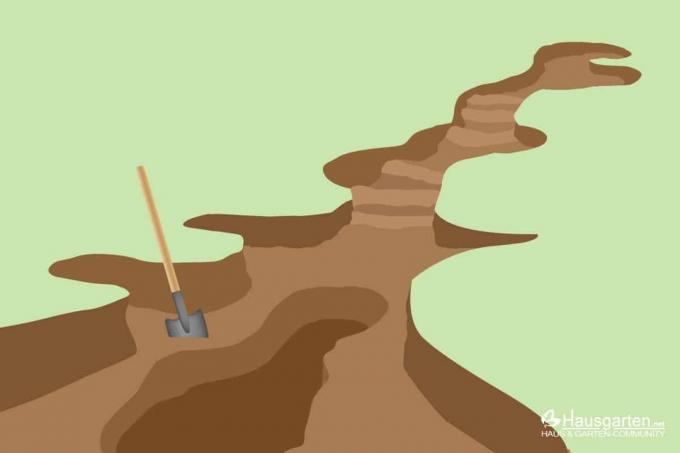
In addition, when choosing the location and the flow rate of the water, it is important to consider that standing water attracts mosquitoes. A small stream next to the terrace is a visual and acoustic enrichment, but it also has the disadvantage of many insects if the water only runs moderately into the garden pond. A waterfall, on the other hand, destroys surface tension and prevents mosquitoes from settling on the stream to breed.
tools and materials
Do-it-yourselfers have three different methods to choose from when it comes to laying a stream on their own property. The following list of benefits illustrates why concrete blocks are a worthwhile alternative to traditional foil or plastic stream bowls.
- high leakage security
- weather resistant
- durable
- suitable for any decoration
A disadvantage compared to the alternatives mentioned is that discrepancies can no longer be rectified after concreting. A foil to line the river bed is necessary in any case.
Once the planning is complete, the do-it-yourselfer pours the concrete into the appropriate mold. For concreting he needs the following tools:
- Spade or mini excavator (depending on the depth of the waterfall)
- garden or hedge trimmer
- cutter knife
- wooden board
- gravel
- level
- pond fleece
- mortar
- water pump
- compatible pressure hose (suitable for the length of the stream)
- sand for filling
- waterproof safety clothing (work gloves, rubber boots, etc.)
- Suitable concrete mass
Tip:
If the excavated material is to be reused for later design, it is worth renting a container. For small quantities, a simple tarpaulin serves as a storage option.
The slope
In order for the water to flow independently, a constant gradient of around 2% to 5% is necessary. The value determines the flow speed with which the water masses splash into the garden pond. Even if nature does not provide a suitable gradient, a standstill can be avoided with just a few interventions. It makes more sense to move the stream deeper into the earth than to build a hill. For this purpose, the do-it-yourselfer places the river bed about 15 cm to 20 cm deeper in the earth.
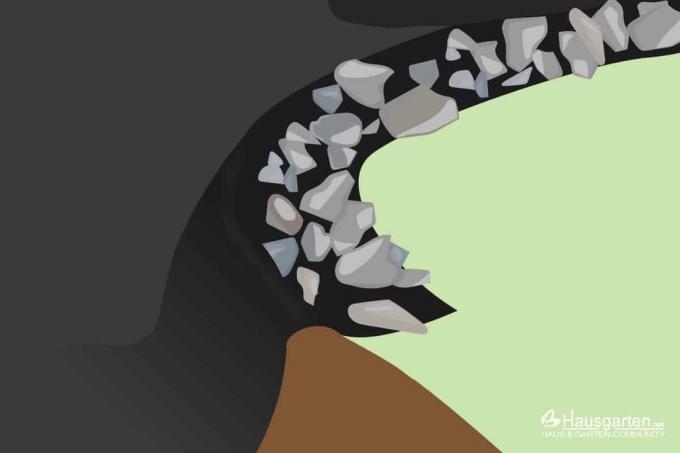
However, the stream must not fall too steeply, otherwise the water will fall down too quickly, taking decorations and small creatures with it. Here, too, there are empirical values that guarantee a consistent flow rate. The norm is: about 1.5 liters of water per minute should flow into the collection basin per centimeter of width.
If the slope is too steep, there are several ways to flatten the gradient:
- Integrate steps and routes into the stream
- expand the width
- lower the creek bed
- Install obstacles such as stepping stones
- incorporate bends
The catch basin
Most streams end in a small pond. However, this can also be replaced by a tiny collecting basin consisting of a plastic bowl, as long as it has enough capacity to install the pump. The size of the catchment basin must match the amount of water drained to avoid flooding. For this purpose, the do-it-yourselfer orients himself to the guide value mentioned above.
The building instructions
- mark the planned course with wooden sticks
- at this point the lawn or remove the top layer of soil
- starting at the source, digging out the bed of the stream
- then work downwards from the top to the garden pond
- build in the steps you want
- remove all roots from the stream bed
- compact the earth well
- Lay the wooden board over the stream and use the spirit level to check that it is straight
- Scatter the course with sand
- Spread out the pond fleece
- Place the foil over it and smooth it out (must protrude slightly at the edges)
- Bend the overhanging foil with the underlying fleece into an S-shape so that a small hollow is formed at the edge of the bank
- fill them with gravel
- mix the concrete and pour it into the stream bed (note the note)
- get in shape immediately
- Cut off the overhanging pond liner with the cutter knife
- Place pipe at source and fix with mortar
- Fill the creek with gravel, fix with mortar if necessary
- touch up unsightly spots on the edge of the bank
- pump approx. Place 80 cm deep in the collecting basin
- Make the pipe connection to the muzzle
- Let the water run in and see if it overflows the banks at any point

The design
A self-constructed stream can be beautified with various decorative elements, individualized and adapted to the rest of the garden design. A small waterfall is particularly suitable in rock gardens, on Mediterranean properties or in Japanese gardens. There are no limits for your creativity. For example, boulders or other concrete stones can decorate the bank. The do-it-yourselfer can also lay out potsherds or build a bridge here. It looks particularly pretty when the stream ripples in the glow of solar lighting at dusk.
Tip:
When designing a stream, less is more. Excessive bank decoration looks overloaded, makes maintenance difficult and draws attention away from the waterfall.
The most natural effect, however, is a planting of the shore zone. Many varieties feel at home near water, some even thrive directly in the garden pond. When choosing the plants, the gardener must of course pay attention to the site requirements such as the lighting conditions and the sensitivity to waterlogging.
Appropriate stones for embellishment
After the concrete has been poured, the do-it-yourselfer can immediately give his stream a natural look by placing natural stones in the still liquid cast. Granite, sandstone, basalt or quartzite harmonize particularly well with a waterfall. Washed pebbles or boulders are also suitable stones to loosen up the overall picture.
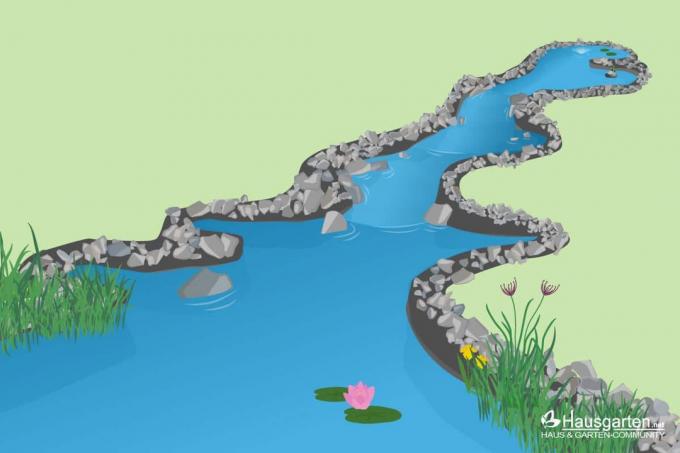
Appropriate bank planting
- bugle (Ajuga reptans)
- lady's mantle (Alchemilla mollis)
- Japanese flag iris (Iris ensata)
- Cuckoo Campion (Lychnis flos-cuculi)
- meadowsweet (Filipendula ulmaria)
- water dost (Eupatorium cannabinum)
- meadow knotweed (Polygonum bistorta)
- meadow iris (Iris sibirica)
Suitable aquatic plants
- Bach Honorary Award (Veronica beccabunga)
- Burning buttercup (Ranunculus flammula)
- Umbellated swan flower (Butomus umbellatus)
- English water mint (Preslia cervina)
- Heartleaf Frogspoon (Alisma parviflora)
- Pennywort (Lysimachia nummularia)
- Narrow-leaved cotton grass (Eriophorum angustifolium)
- Swamp Forget-Me-Not (Myosotis palustris)
A notice:
A stream in your own garden is an enrichment, especially for animal lovers and insect watchers. Bees and butterflies find food and shelter in a colorfully blooming bank planting. Birds like to come to the catch basin to drink.
 garden editorial
garden editorial I write about everything that interests me in my garden.
Learn more about creating a pond

Laminate pond | 6 tips for working with GRP
Ponds were and are eye-catchers, animation and variety in many garden designs. They are particularly durable when made of plastic reinforced with glass fiber. However, if you want to process GRP yourself, you should know a few helpful tips in order to skilfully avoid recurring errors and problems.
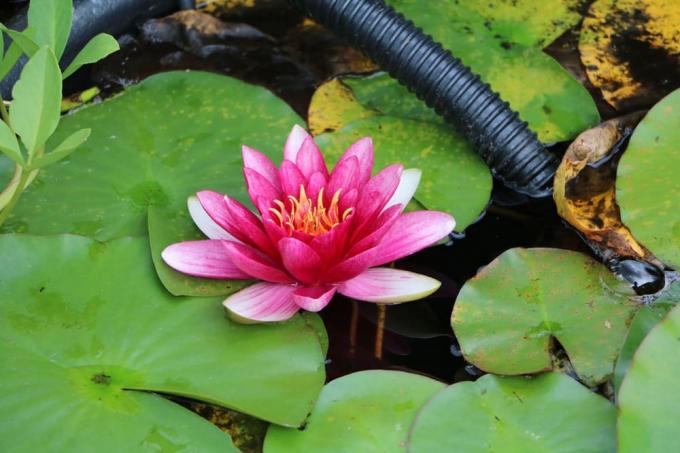
Designing the edge of the pond | 10 ideas for pond borders and pond edge design
If you want to design your pond edge, there are numerous ideas for hiding it. Especially after using pond liner, gardeners rely on a pond border, as this covers the liner and the pond is attractively integrated into the garden.

Build a wooden jetty on the pond yourself - building instructions for a wooden jetty
You have a garden pond and would like to equip it with a jetty? For many it makes sense to leave this project to a professional, but it really is not difficult to build a pond bridge for your garden yourself.

water basin in the garden | An alternative to the pond?
A refreshing highlight in the creative garden design is a magical water world that invites you to linger with its gentle splashing. Creative home gardeners with a penchant for modern solutions rightly ask: are water basins in the garden a sensible alternative to the traditional pond? With practical reflections, this guide would like to help you decide between a water basin or a pond in the garden.
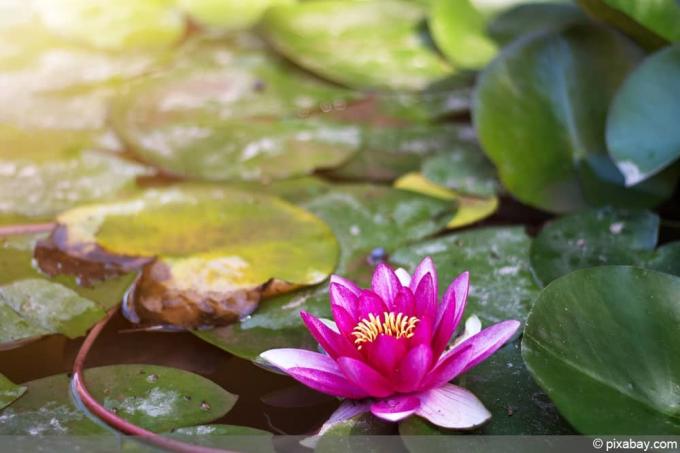
Instructions: Planting the garden pond + 8 beautiful plants for the pond
A garden pond is a very special jewel in every garden. However, in order for it to have an effect, it must be planted. How to do that and which plant grows best where on or in a pond is explained here.

Garden pond: required size + depth for fish - goldfish
A garden pond gives your own green a lively component - especially if goldfish are kept in it. But how big and deep does it have to be so that the fish are safe in it and can get through the winter without any problems? There are answers here.



